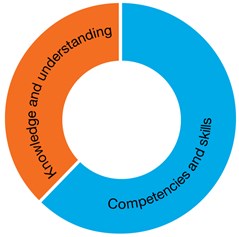The Numeracy capability strongly supports the development of consumer and financial literacy by equipping students to use mathematics in their everyday lives. Numeracy supports the development of the following dimensions of consumer and financial literacy.

Approximate proportion of the dimensions addressed by Numeracy
The most significant contribution numeracy makes to consumer and financial literacy is developing competencies and skills that can be applied to authentic consumer and financial contexts. Through the sub-element called ‘Use money’, students develop an appreciation of the use and value of money and learn to apply this knowledge to purchasing, budgeting and creating financial plans. This learning can be transferred to a range of real-world financial situations; for example, students can calculate the change from simple purchases or develop and evaluate financial plans to support specific financial goals.
Through other elements of the Numeracy capability, students develop a range of skills that enable them to solve and model real-world consumer and financial problems such as calculating how much tax to pay when earning income, calculating how far they should travel to purchase discounted fuel, determining the value of percentage discounts, or calculating interest paid or earned. Students also learn to solve problems in authentic contexts that involve interpreting and evaluating statistical information and identifying patterns and trends. This learning helps students make informed decisions in real-world contexts with confidence and to assess risk based on sound reasoning.
The elements of using spatial reasoning and using measurement have not been included in this mapping. However, there are opportunities to include aspects of these elements in the teaching and learning of consumer and financial literacy. For example, students might cost materials based on measurements, compare the volume or capacity of different products to calculate ‘best buy’, or interpret maps to measure distance and compare the cost of alternative means of transport.
Moneysmart for teachers and Tax, Super and You provide a number of interdisciplinary units and interactive activities that either focus on or include aspects of the Numeracy capability.




